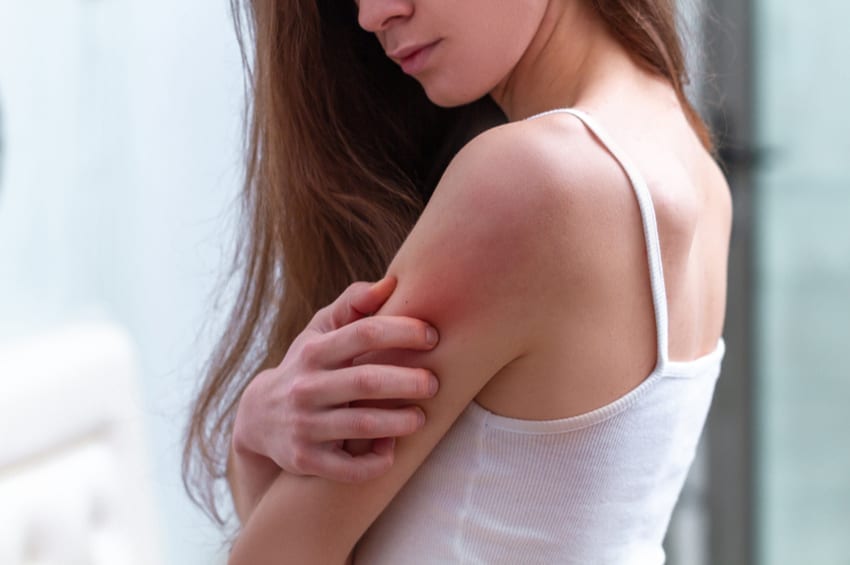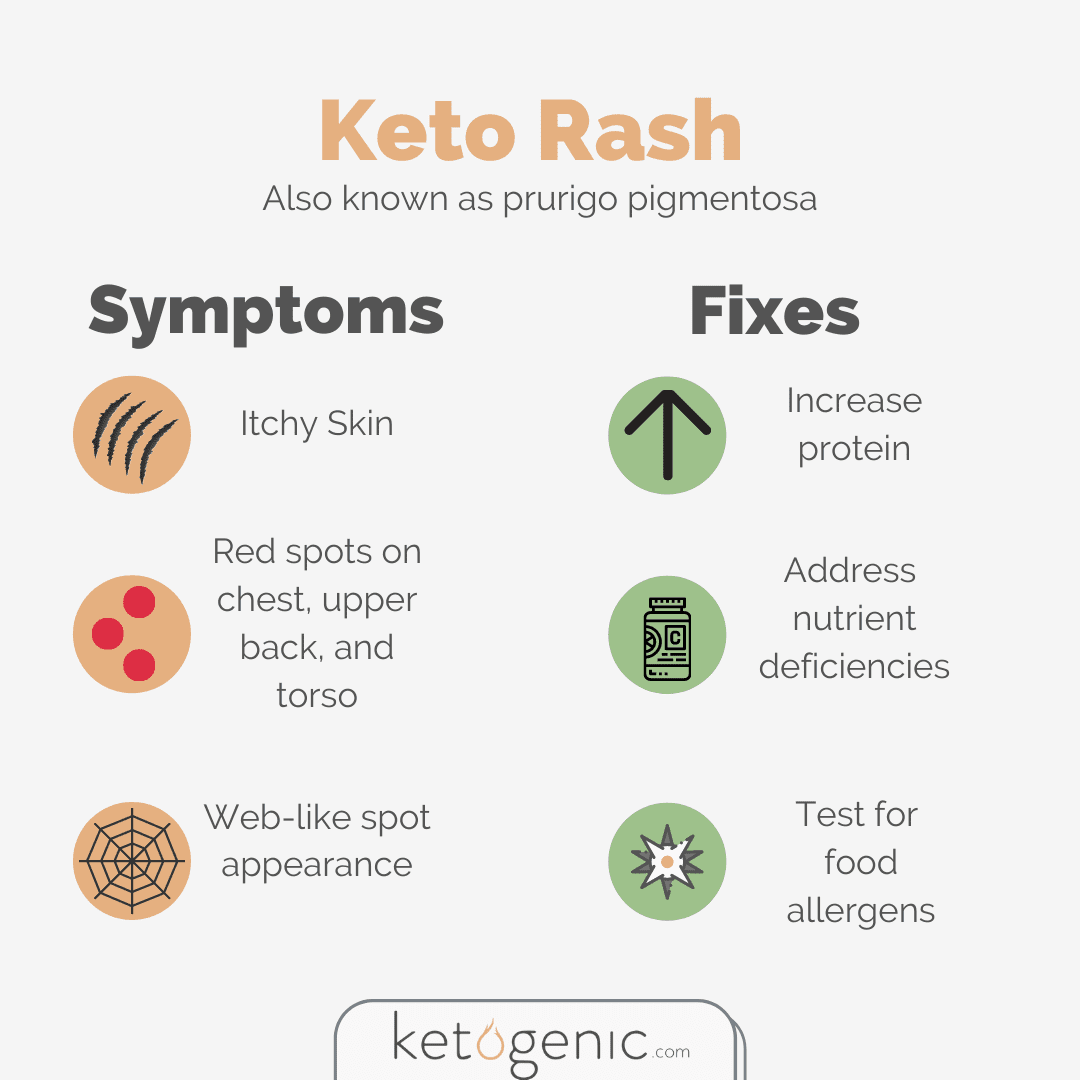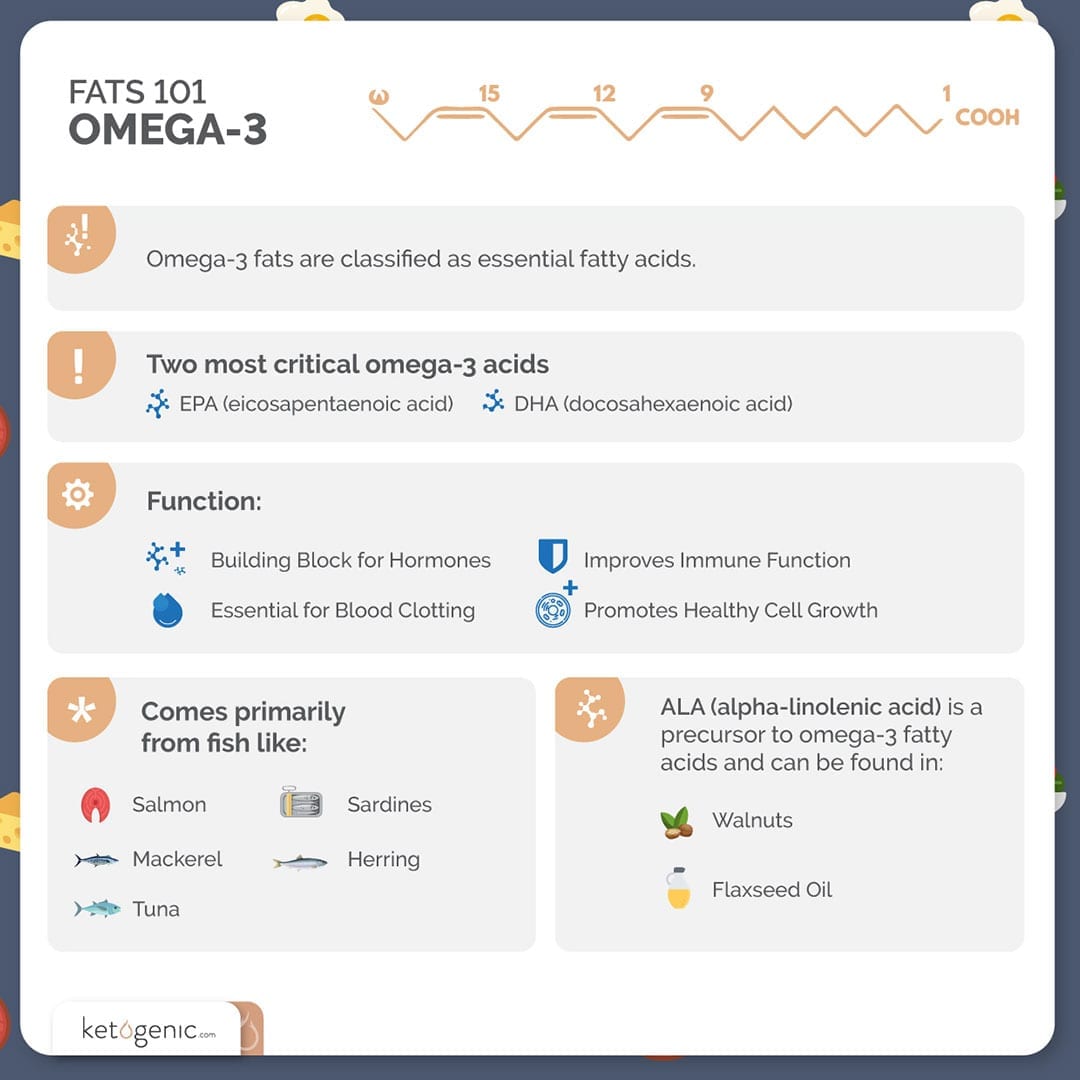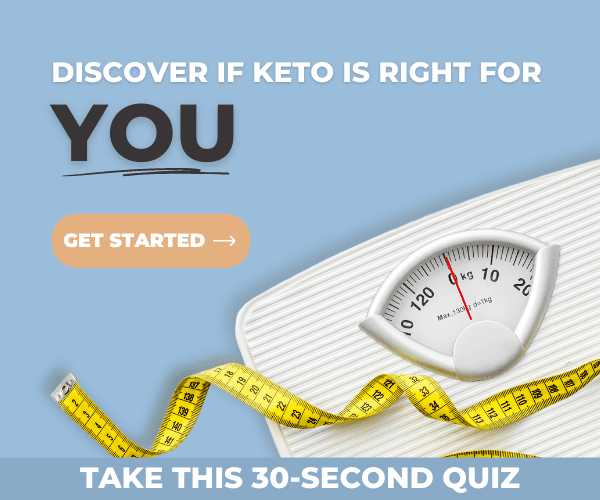
With the low-carb ketogenic diet sometimes comes unwanted side effects…like the keto rash. So, what is this peculiar rash and what can you do about it?
What is the Keto Rash?
On keto, your body runs on ketones from fat instead of glucose from carbohydrates. Some people experience a keto rash (prurigo pigmentosa) — an inflammatory condition of the skin involving a red, itchy rash. The rash usually shows up on the neck, upper back, chest, and abdomen area.
The rash appears as red spots called papules that can have a web-like appearance. Once the spots disappear, there might be a dark brown pattern left on the skin. The keto rash can happen to anyone, but it’s more prevalent in Asian women.
What Causes the Keto Rash?
More research is needed, but there does seem to be a link between the ketogenic diet and prurigo pigmentosa [1] [2] [3]
The rash tends to develop on people who are following a ketogenic diet. The rash might be linked to hormonal and nutrient deficiencies [4].
Certain external factors might exacerbate the skin condition, such as:
- Sunlight
- Excessive heat
- Friction and skin trauma
- Sweating
- Allergens
Some additional factors or medical conditions might also be associated with the keto rash, such as:
- Still’s Disease
- H. pylori infection
- Sjögren’s syndrome

How Do I Prevent the Keto Rash?
Since the exact cause of the keto rash isn’t definitive, it can be difficult to define how to resolve or prevent it. Here are some of the most likely ways to prevent the keto rash:
1) Nutrient Deficiencies
Correct nutrient deficiencies that might be involved in inflammatory skin conditions. Deficiencies in vitamin B-12, A, and C have been associated with acute and chronic skin conditions. If your diet is overly restrictive, you might not be getting enough of these important vitamins and minerals. Try to eat an array of colorful low-carb veggies and a small amount of keto-friendly fruits, some high-quality protein, and healthy fats. The goal is a well-formulated nutrient-dense ketogenic diet. You should also consider your electrolytes. You might need to replenish certain electrolytes, such as magnesium, sodium, or potassium to help regulate your bodily processes [5]
2) Check for Food Allergens
Skin rashes might be the result of a food allergy or sensitivity causing inflammation. On the high-fat, low-carb keto diet, some of the most common food allergens include eggs, dairy, nuts, seeds, and fish. Some keto dieters also eat smaller amounts of certain fruits and grains like wheat. It might be helpful to keep a food diary and monitor how or if your skin condition changes after you eat specific foods. Sometimes food allergies are due to dysbiosis of the gut and issues with the digestive system. You could try an autoimmune paleo or paleo keto-type diet where you eliminate certain food groups, typically for at least two or three months, before adding the food back in and monitoring for a reaction. You could also work with a doctor or nutritionist to determine if you’re dealing with digestive issues or food allergies. Scroll through our keto doctor-finder!
3) Microbiome Diversity!
While in some instances a more restrictive version of a ketogenic diet might help, in other instances, it’s more about microbial diversity in the gut. Consuming a varied diet with lots of different foods can give you more diverse and beneficial bacteria in your digestive system, which might help with inflammation. For example, rotate the leafy greens you eat. Go with kale for a day or two then switch it up and have arugula, spinach, or bok choy. This gives you access to a wide spectrum of vitamins and nutrients. You could also try bone broth to aid with digestive problems. Bone broth is brimming with nutrients, antioxidants, and amino acids, and research shows that gelatin and collagen in the broth can be therapeutic for gastrointestinal disorders like inflammatory bowel disease [6] [7] [8]
4) Alter Your Carbohydrate and Protein Intake
You might need to slightly alter your macronutrients to find a ketogenic diet that’s more comfortable and suitable for you. You might need to start with a mid-to-low-carb diet for a slower introduction and transition into the keto lifestyle.
Eating too little protein has also been shown to cause the keto rash. If altering your carbohydrate intake doesn’t work, try upping your protein intake!
5) Incorporate More Anti-inflammatory Foods and Supplements
If the skin rash has something to do with inflammation, anti-inflammatory foods and supplements might be helpful. In clinical studies, probiotics, prebiotics, fish oil, and vitamin D have all been used to improve the symptoms of dermatitis [9]. Evening Primrose oil might also be a good choice according to the current literature [10].
Consume anti-inflammatory foods, such as low-carb fruits and vegetables that contain flavonoids, such as berries, onions, and kale. Research shows flavonoids and other compounds in foods have anti-inflammatory properties [11] [12].

Try to take care of your skin the best you can with lukewarm water for bathing and showering and choosing gentler soaps and cleansers that won’t irritate your skin. Moisturize and soothe your skin with more natural products, such as coconut oil! If it’s healthy and safe to eat, it’s a better choice to put on your skin than an unknown chemical you can’t pronounce.
How Do You Prevent the Keto Rash?
Share your tips on preventing the keto rash with the keto community!
References
Wong, M., Lee, E., Wu. Y., & Lee, R. (2018).Treatment of prurigo pigmentosa with diet modification: A medical case study.Hawai’i Journal of Medicine & Public Health, 77(5), 114-117.
Onaygil, E., Songur, A., Kutlubay, Z., & Demirkesen, C. (2015). Early stage prurigo pigmentosa: A case report.Turkish Journal of Pathology,
Michaels, J. D., Hoss, E., & Price, H. (2015). Prurigo pigmentosa after a strict ketogenic diet. Pediatric Dermatology,
Almaani, N., Al-Tarawneh, A. H., & Msallam, H. (2018). Prurigo pigmentosa: A clinicopathological report of three middle eastern patients. Pediatric Dermatology,
Basavaraj, K. H., Seemanthini, C., & Rashmi, R. (2010). Diet in dermatology: Present perspectives. Indian Journal of Dermatology, 55(3), 205-210.
Proksch, E., Segger, D., Degwert, J., Schunck, M., Zague, V., & Oesser, S. (2014).Oral supplementation of specific collagen peptides has beneficial effects on human skin physiology: A double-blind, placebo, controlled study. Skin Pharmacology and Physiology, 27(1), 47-55.
Frasca, G., Cardile, V., Puglia, C., Bonina, C., & Bonina, F. (2012). Gelatin tannate reduces the proinflammatory effects of lipopolysaccharide in human intestinal epithelial cells.Clinical and Experimental Gastroenterology, 5, 61-67.
Koutroubakis, I. E., Petinaki, E., Dimoulious, P., Vardas, E., Roussomoustakaki, M., Maniatis, A. N., & Kouroumalis, E. A. (2003). Serum laminin and collagen IV in inflammatory bowel disease.Journal of Clinical Pathology, 56(11), 817-820.
Schlichte, M. J., Vandersall, A., & Katta, R. (2016). Diet and eczema: A review of dietary supplements for the treatment of atopic dermatitis. Dermatology Practical & Conceptual, 6(3), 23-29.
Mohajeri, S., & Newman, S. A. (2014). Review of evidence for dietary influences on atopic dermatitis. Skin Therapy Letter, 19(4)
Watzl, B. (2008). Anti-inflammatory effects of plant-based foods and of their constituents.International Journal for Vitamin and Nutrition Research, 78, 293-298.
Serafini, M., Peluso, I., & Raguzzini, A. (2010). Flavonoids as anti-inflammatory agents.Proceedings of the Nutrition Society, 69(3), 273-278.









